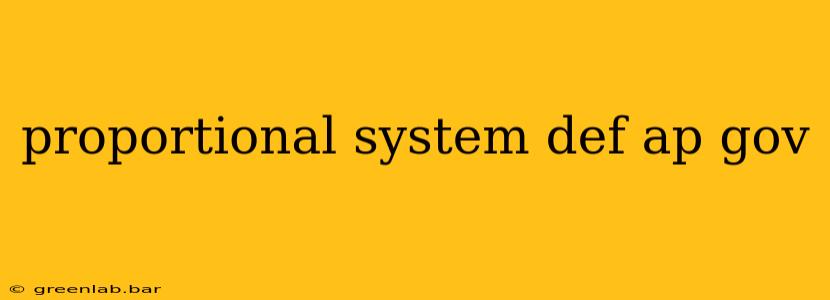Proportional representation (PR) is a crucial concept in AP Government and Politics, representing a fundamental difference in how democracies elect their representatives compared to the winner-take-all system prevalent in the United States. Understanding PR is key to analyzing various political systems and their implications. This in-depth guide will explore the intricacies of proportional representation, clarifying its mechanics, advantages, disadvantages, and its impact on the political landscape.
What is Proportional Representation?
Proportional representation, in its simplest form, is an electoral system where the number of seats a party receives in the legislature is directly proportional to the number of votes it receives in the election. Unlike winner-take-all systems, where the candidate with the most votes in a district wins regardless of the percentage, PR aims to ensure fairer representation across the political spectrum.
Types of Proportional Representation Systems:
Several variations of PR systems exist, each with its own nuances:
-
Party-list proportional representation: Voters choose a political party, and seats are allocated based on the party's overall vote share. This is further divided into closed-list systems (the party determines the order of candidates) and open-list systems (voters can rank candidates within a party's list).
-
Mixed-member proportional representation: This hybrid system combines elements of PR with single-member districts. Voters cast two votes: one for a candidate in their district and one for a political party. Seats are then allocated to ensure overall proportionality across the legislature. Germany utilizes this system effectively.
-
Single transferable vote (STV): Voters rank candidates in order of preference. Candidates who reach a quota of votes are elected, and surplus votes are transferred to other candidates based on voter preferences, ensuring a more nuanced and representative outcome. Ireland and Australia are examples of countries using STV.
Advantages of Proportional Representation:
-
Fairer Representation: PR systems ensure minority parties and independent candidates have a greater chance of securing seats, leading to a more diverse and representative legislature. Smaller voices are amplified.
-
Increased Voter Turnout: Knowing their vote has a greater impact, even if their preferred party doesn't win the majority, can increase voter participation.
-
Coalition Governments: PR often leads to coalition governments, necessitating compromise and collaboration between different parties. This can result in policies that are more inclusive and reflect a wider range of viewpoints.
-
Reduced Wasted Votes: In winner-take-all systems, votes for losing candidates are essentially wasted. PR minimizes this, as even smaller parties can gain legislative representation based on their vote share.
Disadvantages of Proportional Representation:
-
Coalition Instability: Coalition governments can be unstable, prone to collapse if coalition partners disagree or lose support.
-
Power to Smaller Parties: Small parties can hold significant power in coalition negotiations, potentially disproportionate to their actual popular support. This can lead to policy gridlock.
-
Difficulty Understanding: The mechanics of some PR systems can be complex for voters to understand, potentially hindering their participation.
-
Potential for Extremist Parties: PR can give a platform to extremist parties who may not have succeeded in a winner-take-all system, leading to concerns about their influence within government.
Proportional Representation vs. Winner-Take-All: A Comparison
The key difference lies in how votes translate into legislative seats. Winner-take-all systems concentrate power, while PR aims for a more proportionate distribution. This impacts the representation of minority views, government stability, and the overall political landscape. Understanding this fundamental difference is crucial for AP Government students.
Conclusion:
Proportional representation offers a distinct alternative to winner-take-all systems. While it presents advantages in terms of fairer representation and inclusivity, it also faces challenges concerning government stability and the potential influence of smaller or extremist parties. Analyzing the effectiveness of PR requires a careful consideration of its various forms, their impact on political dynamics, and the specific context within which they operate. This detailed examination equips AP Gov students with a deeper understanding of comparative political systems and their implications for democratic governance.

